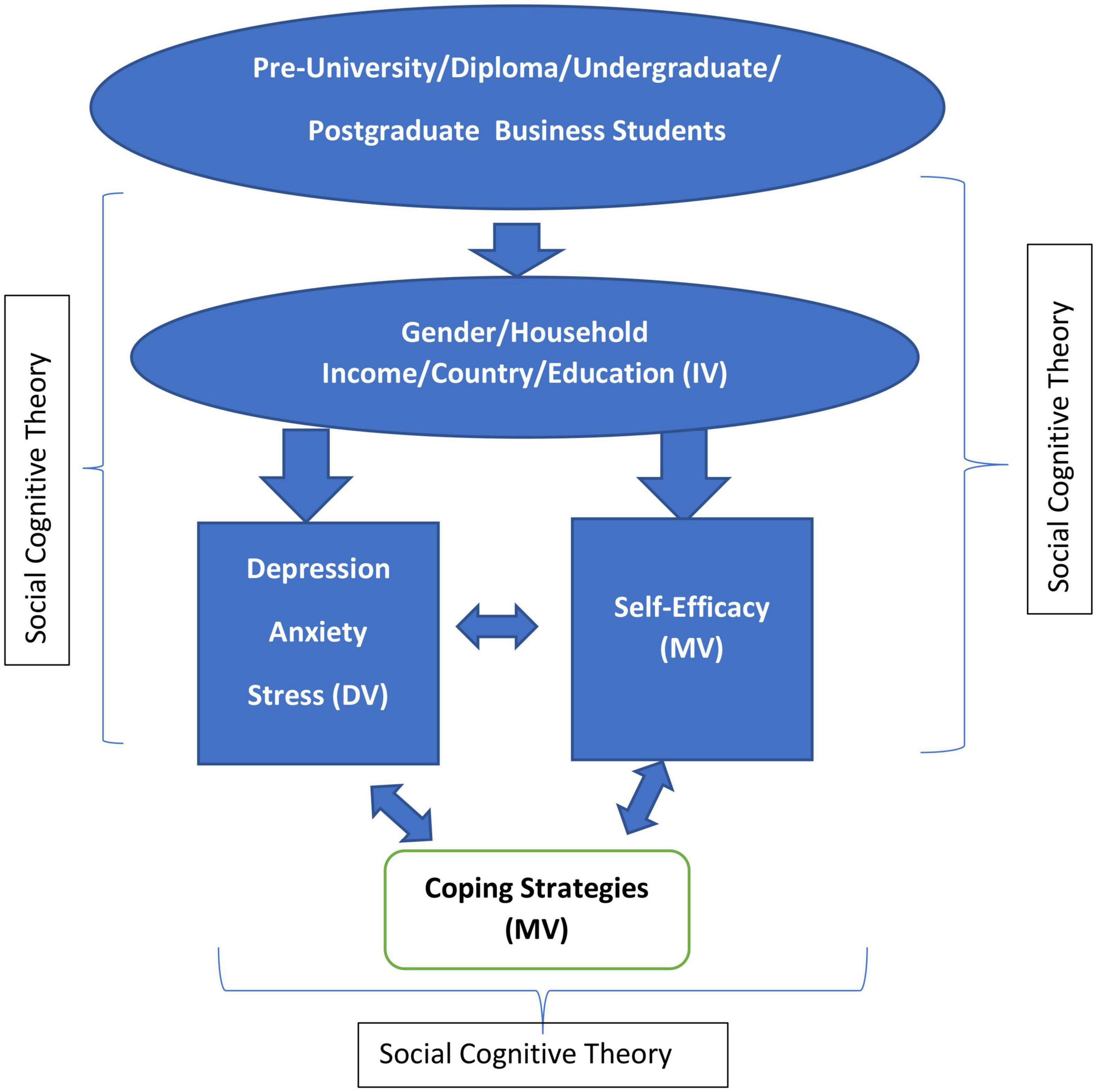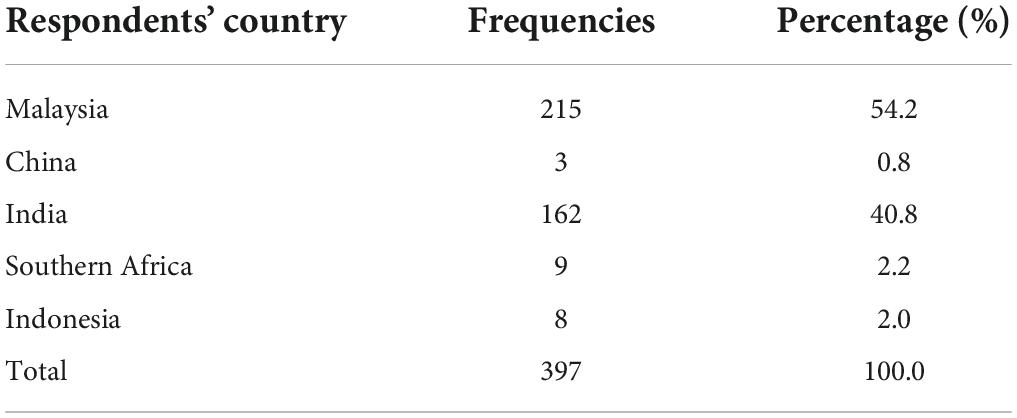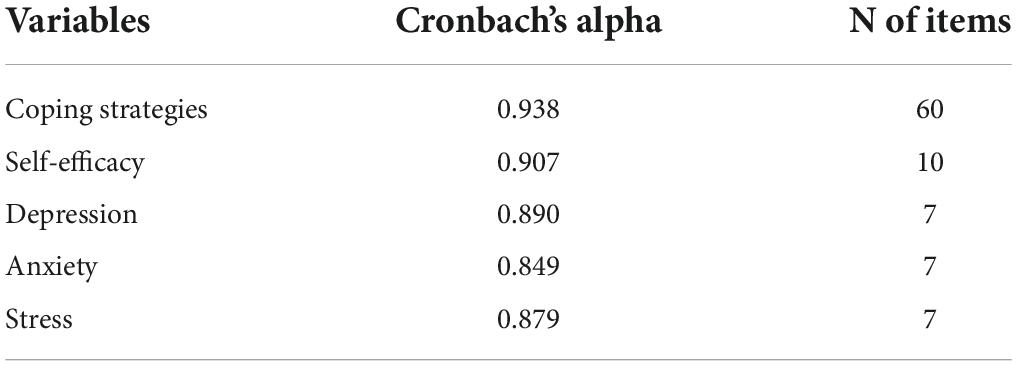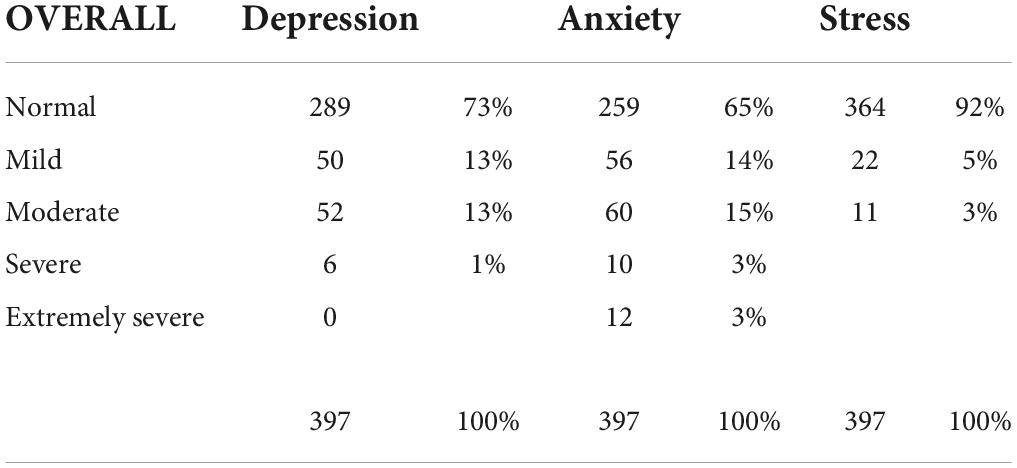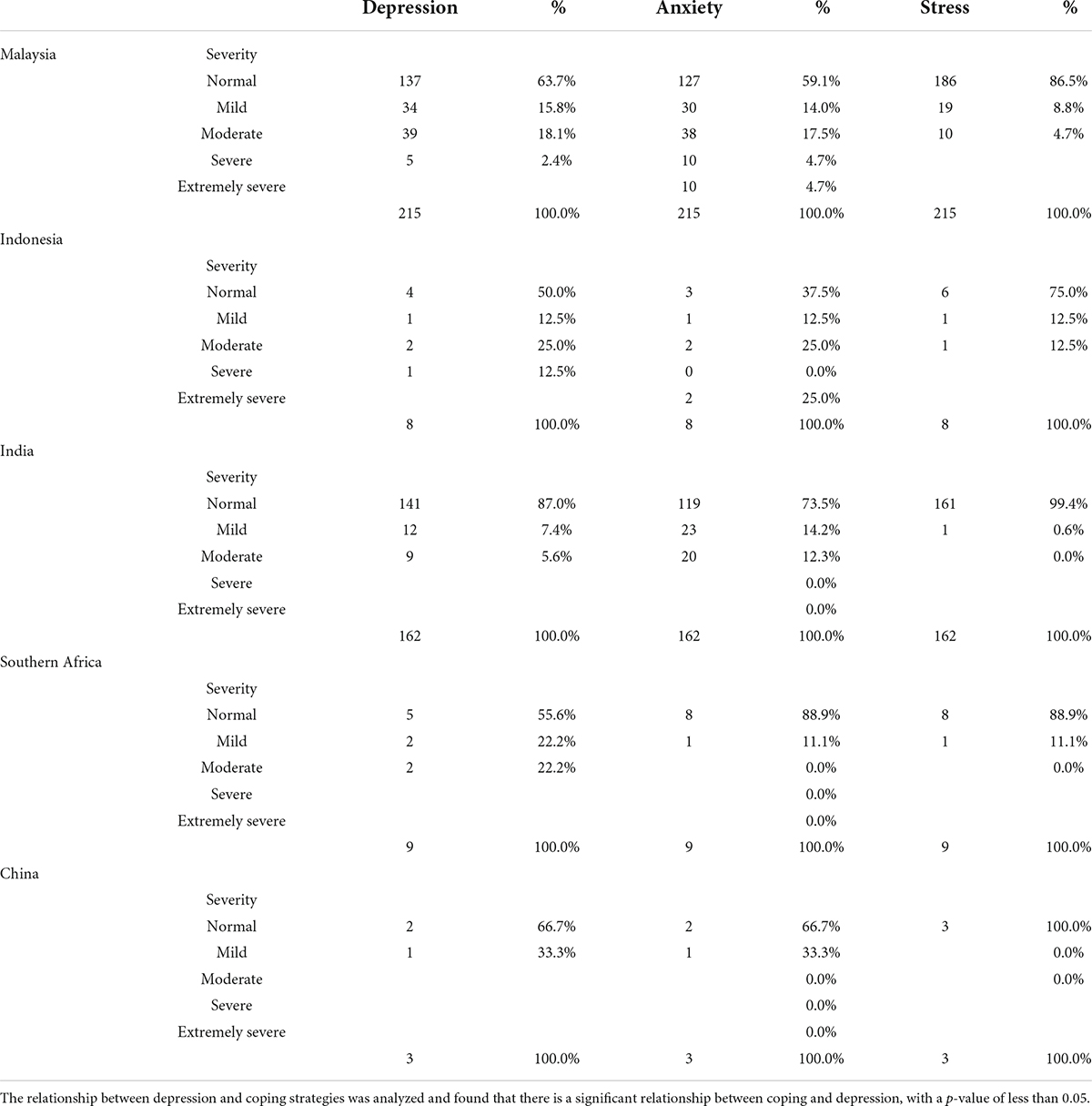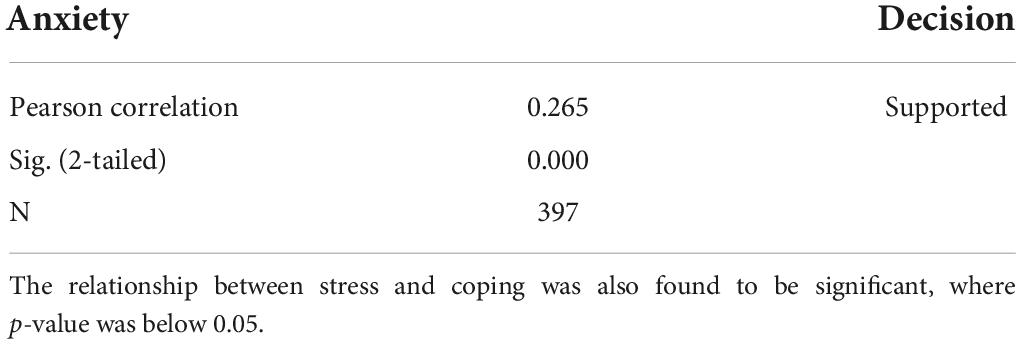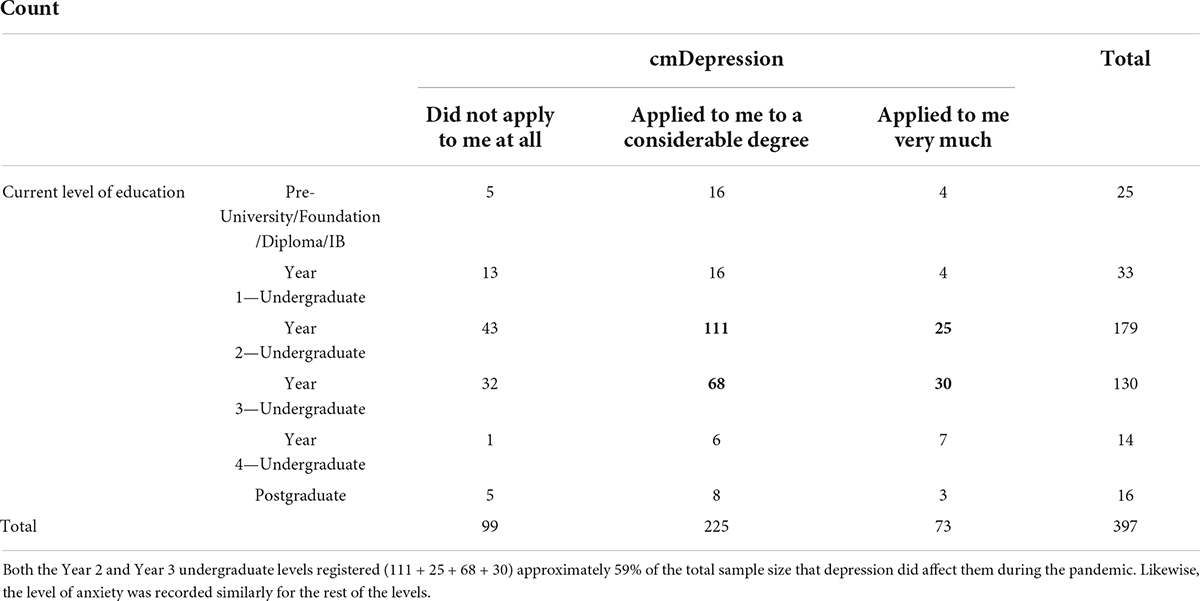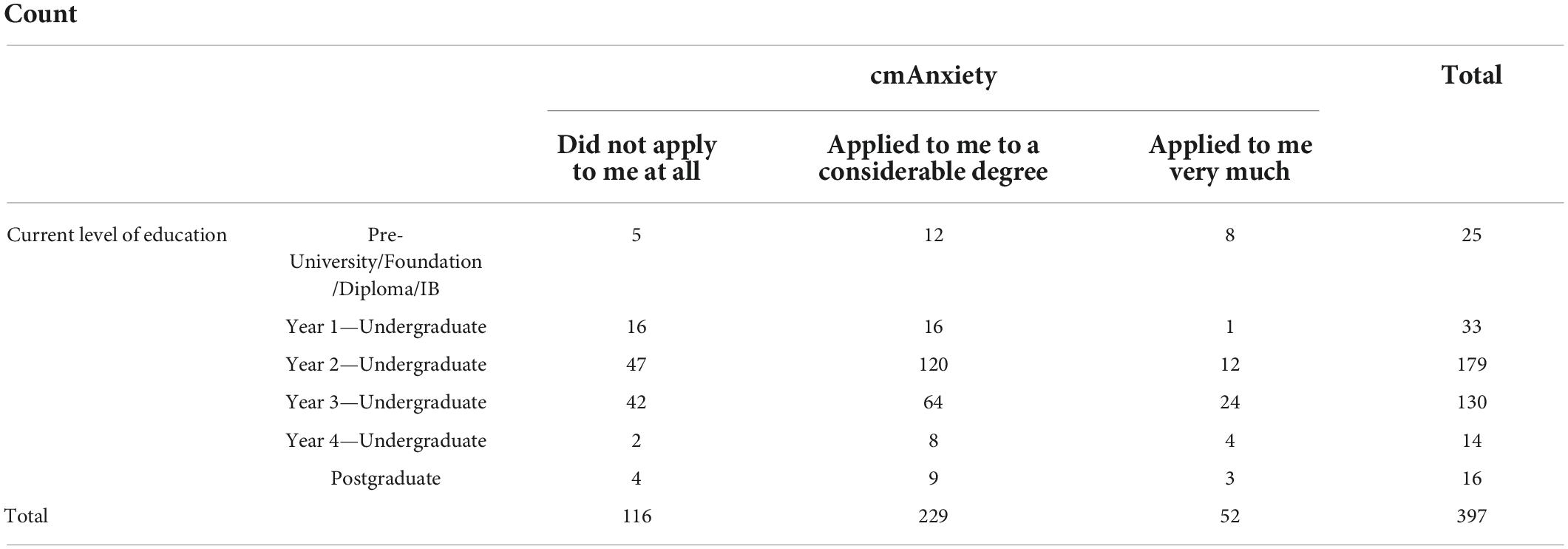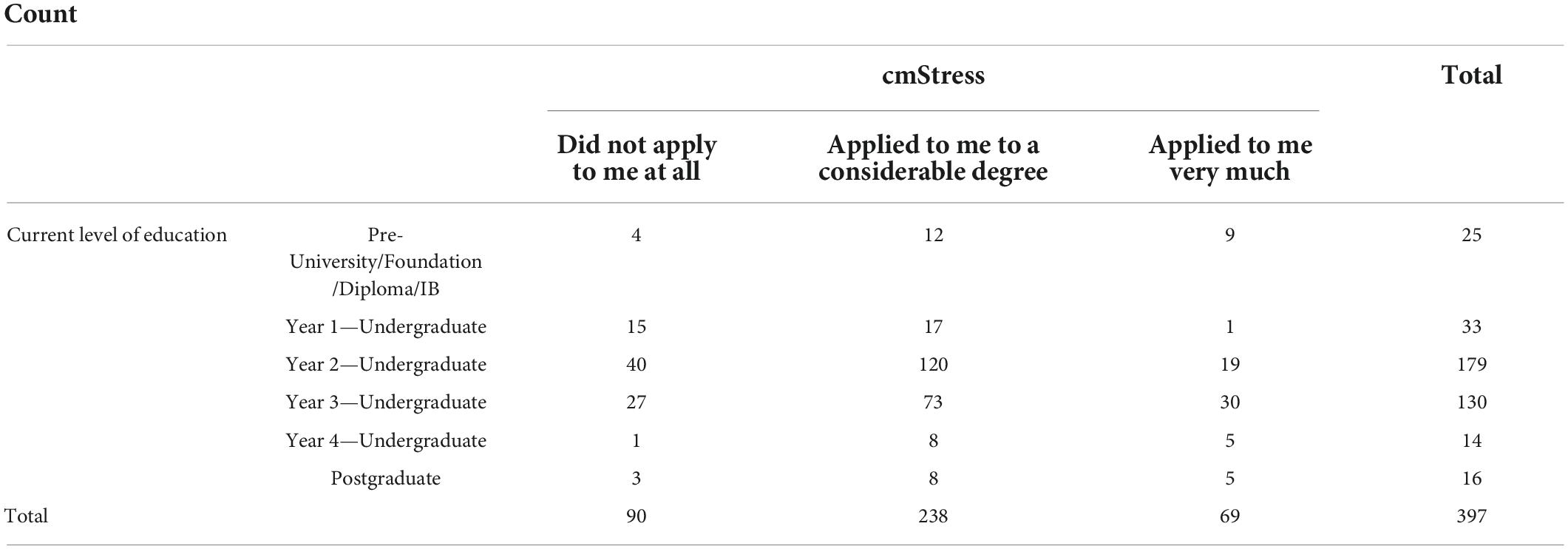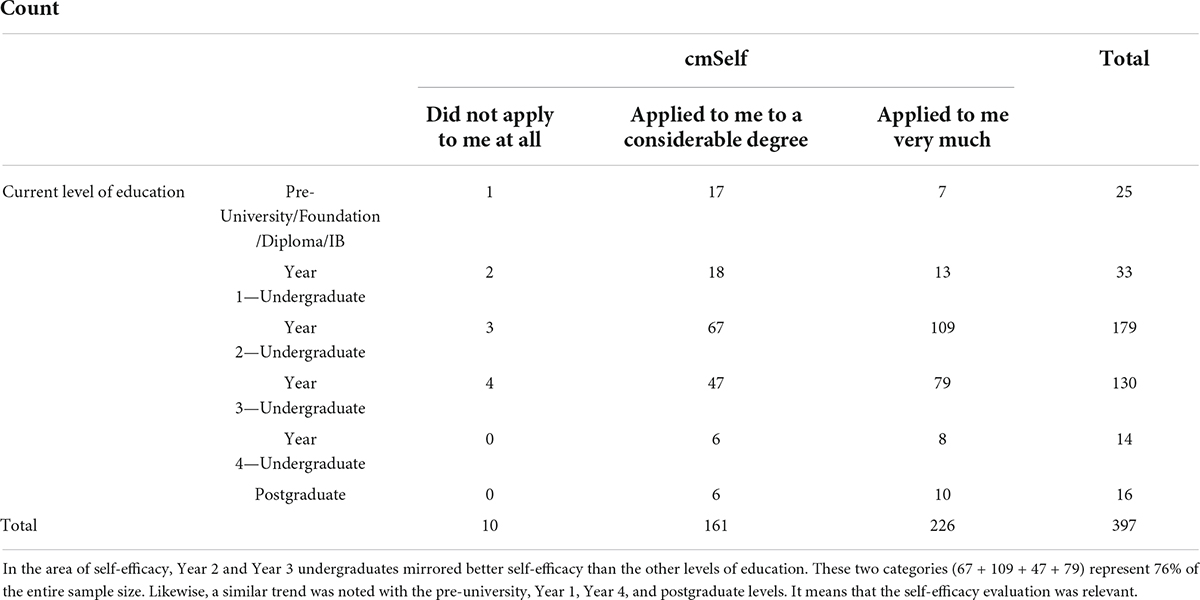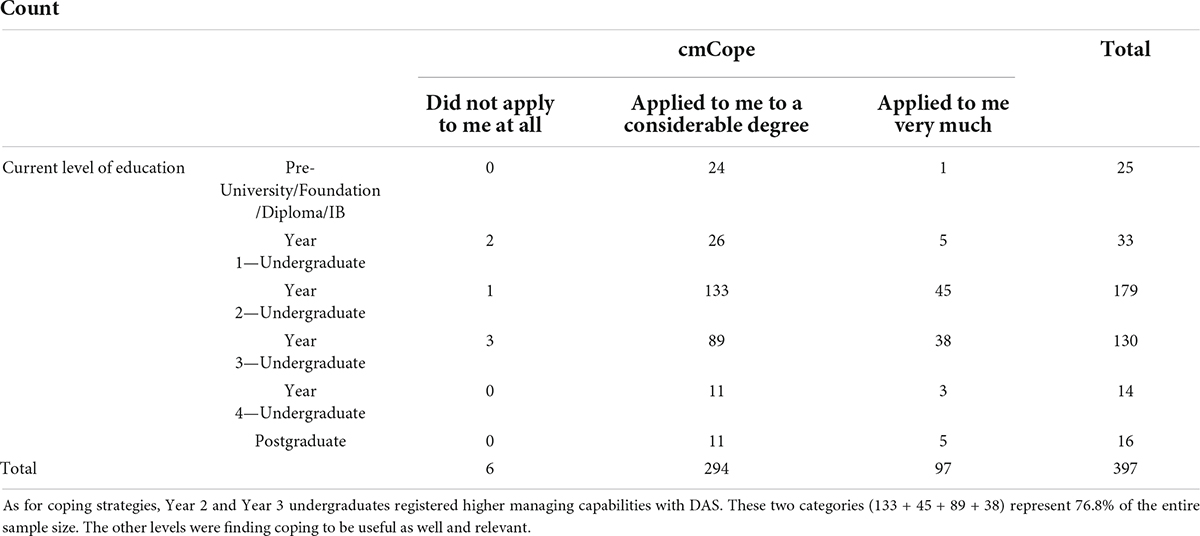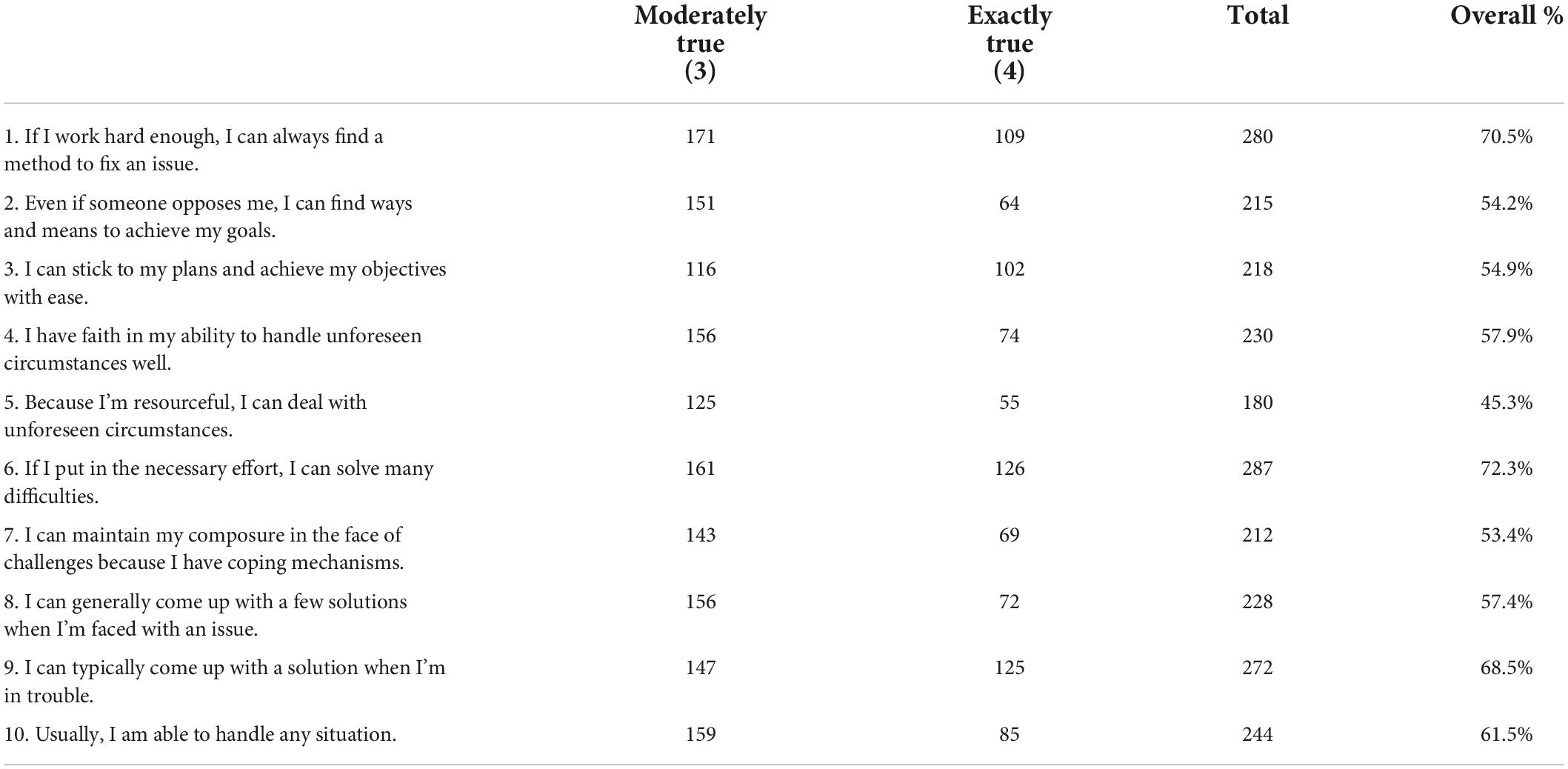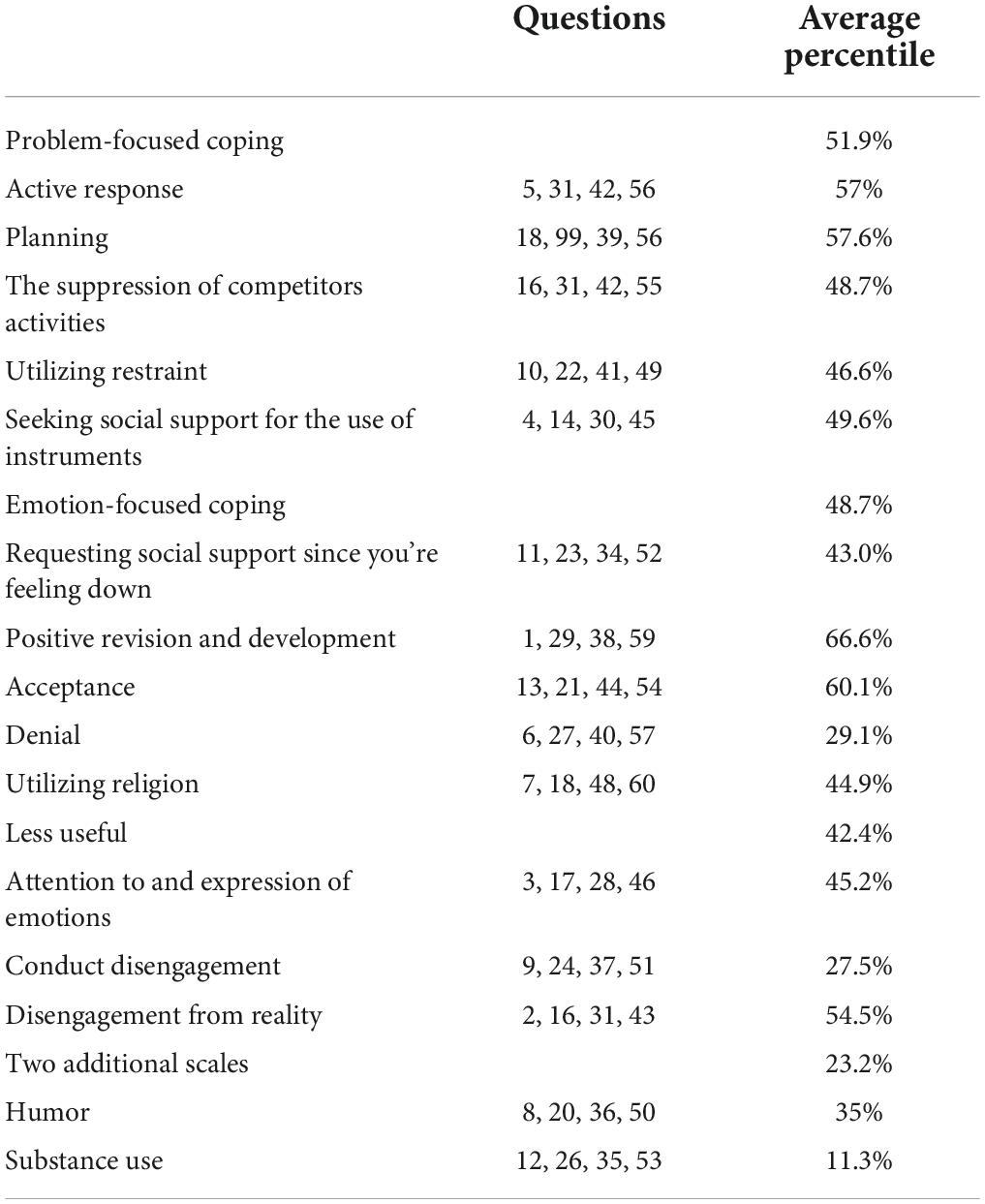- 1Faculty of Management in Production and Transportation, Politehnica University of Timişoara, Timişoara, Romania
- 2Sunway College, Kuala Lumpur, Malaysia
The higher education sector was affected by this pandemic, managing enduring challenges since early 2020. Institutions of higher learning (IHL) are prepared to address unsurmountable challenges to ensure that students are not deceived and are being given the proper nurture, coupled with adherence to syllabuses. Simultaneously, the COVID-19 pandemic has caused unscrupulous pressure on students of these institutions. The psychological waves are creating mammoth consequences, affecting the beneficiaries of the higher education system and their families. In recent years, with limited studies on psychological impact among tertiary students on a cross-country basis, general self-efficacy, and the degree of coping strategies, we were motivated to investigate the degree of depression, anxiety, and stress (DAS), among this cohort of students encompassing the pre-university/Diploma, 1st–4th-year undergraduate, and postgraduate students from private universities in Malaysia, Indonesia, India, Southern Africa, and China, representing the emerging economies. A cross-sectional survey was conducted, followed by quantitative analysis. The objective of this study was to recognize whether there is a relationship between the psychological impact of DAS and the coping strategies adopted by the undergraduate students responding during the lockdown. The findings of this study revealed that with a sample size of 397, DAS lacked any severe impact on students across gender, country, household income, and level of education. DAS was established to be well managed with a coping strategy and self-efficacy established. This study resulted in a deeper understanding of DAS among undergraduates in emerging economies and their degree of coping behavior, providing a glimpse of the approach of millennials to handle DAS during the pandemic.
Introduction
The COVID-19 pandemic introduced a significant and profound impact on global society and affected the very fabric of society, leaving irreconcilable scars. The incidence of increased mortality and the mental stress condition of societies cannot be ignored. Population general health is something worth making progress toward. At different stages, the health propensities that are best for individuals will change when the life of these individual changes. Wellbeing must be drawn nearer in a comprehensive manner that considers both physical and mental. According to the World Health Organization [WHO] (2020), health is defined as “a state of complete physical, mental, and social wellbeing and not merely the absence of disease or infirmity.” Thus, mental health is crucial as it affects emotions and leads to how we feel, think, and act. According to WHO (2021), depression is a common mental disorder, and it is estimated that 5% of adults suffer from depression. University students are a special group of people who are at the peak of the transition period from initial adulthood to adulthood which can be one of the most challenging periods in one’s life. New campus environment, fresh cohort of students, tight assignment deadlines, mastering new skills, away from family, and uncertain job opportunities cause anxiety for students which contributes to stress and depression. Holmes et al. (2020) posit that this pandemic has brought about considerable mental health issues. Prior to this study, there were numerous studies highlighting the issue of a high surge in mental health (Ibrahim et al., 2013; Rotenstein et al., 2016).
Studies on depression, anxiety, and stress (DAS) have had mixed results. Studies by Thombs et al. (2020) indicated that in a longitudinal study, it was found that there was a small to negligible increase in mental health issues. Simultaneously, studies by Fancourt et al. (2021) highlighted that there were decreasing levels of anxiety and depression during the beginning period of the lockdowns in the United Kingdom. A similar surprise was found in a study by Fried et al. (2020), in which there were decreasing levels of depression, anxiety during the COVID-19 pandemic, contrary to the studies by Elmer et al. (2020) and Huckins et al. (2020) which reported that such levels were increasing during the pandemic. Similarly, a study by Fawaz and Samaha (2021), using quantitative methodology, involving 520 Lebanese undergraduate university students found that in an E Learning environment, there was an increase in DAS. Further studies by Baloran (2020), Capone et al. (2020), Lai et al. (2020), Nurunnabi et al. (2020), Wathelet et al. (2020), Almomani et al. (2021), Jiang et al. (2021), Mekonen et al. (2021), Patias et al. (2021), Sood and Sharma (2021), and Villani et al. (2021) postulate that the COVID-19 pandemic has resulted in mental and emotional disorders among tertiary students, leading to behavior abnormalities and health challenges. An additional study by AlAteeq et al. (2020) reported females and university students showed significant association with stress level. Luke et al. (2021) conducted a similar survey and proposed that depression, stress, and anxiety are extremely prevalent among university students even after the lockdown was lifted. However, in another student involving 1,836 Swedish university students, concluded that the level of DAS indication was steady during the first 3 months of the pandemic but declined during the summer months. In their studies (Cioca et al., 2019; Mohsin et al., 2022), they show the importance of investigating personal factors on student development. Furthermore, our study employs the general self-efficacy scale (Schwarzer and Jerusalem, 1995), as a moderator to identify the strategies that exist that are intended to mitigate the level of DAS. These influences are felt in the academic environment and in the business environment.
This research topic is limited in Malaysia and lacks information regarding the involvement of university students on a cross border sample size, and using general self-efficacy scale with coping strategies, the authors of this study found that it necessitates to discover the level of DAS among university students in Malaysia and emerging markets during this pandemic. The aim of this study is to recognize whether there is a relationship between the psychological impact of DAS and the coping strategies adopted by the university students during the lockdown. Aside from this, our study employs the general self-efficacy scale (Schwarzer and Jerusalem, 1995), as a moderator to identify the coping strategies which are intended to mitigate the level of DAS. In addition, this study engages the social cognitive theory (Bandura, 1986, 2008), as its theoretical stance, which holds that environment, cognition, and behavior are key influencers on the belief system of an individual. In social cognitive theory, self-efficacy is seen as a source with respect to stress vulnerability. Therefore, an event can be viewed as negative only after a negative cognitive assessment.
The pandemic period requires conducting studies on the impact of DAS factors on student development. This research investigates the relationship between the psychological impact of DAS and the coping strategies adopted by the research respondents during the lockdown period. This period is essential for students and develops traces on their professional development. This study would result in a deeper understanding of DAS among tertiary students in emerging economies and their degree of coping behavior, which will allow regulators and institutions to better address DAS in institutions of higher learning (IHL), coupled with prudent mitigation actions. This work contributes to good decisions in higher education and to the expansion of research carried out during the pandemic by presenting the results obtained.
A global overview of the COVID-19 pandemic
The World Health Organization (WHO) notified on 27 March 2020, at the start of the COVID-19 pandemic, that stress, anxiety, and fear would increase the result of this negative circumstance, which would cause uncertainty and concern among people of all ages (World Health Organization [WHO], 2020). To fight the onslaught of this deadly virus, the lockdown that followed the unexpected outbreak had turned people from social “creatures” to isolated humans. Research on the COVID-19 pandemic by Sifat (2020) revealed that suicide, domestic violence, mental disorders, anxiety, and depressive disorders were increasing in most countries. The pandemic continued to report new cases of infection as well as a concerning increase in the number of fatalities worldwide (Taucean et al., 2019; Sundarasen K. et al., 2020).
The higher education system has been affected by the COVID-19 pandemic. Higher education institutions, colleges, schools, and pre-schools in most affected countries resorted to online learning, which is a new learning experience for many students of varying ages (Sifat, 2020). Some psychological problems were subsequently reported, such as anxiety, depression, frustration, and trauma affecting students due to strict physical and social distancing in most countries and in more severe instances, total isolation. The adverse impact on students had impacted the entire teaching-learning environment, as evidenced in the literature in many countries and regions (UNESCO, 2021).
In the United States (US), Browning et al. (2021) in their recent research on psychological impacts among university students across seven states in the US reveal that university students are increasingly being recognized as a vulnerable population who suffer from higher levels of anxiety, depression, and even substance abuse and eating disorders as compared to the general population.
In contrast to similar findings across many countries as discussed above, Johansson et al.’s (2021) research across six universities in Sweden revealed a different set of findings. Using a DASS-21 data collection tool, which is a reputed measurement tool for all psychometric variables, thus limiting the risk of misclassification, the scholars conducted a prospective sample involving 1,836 full-time final-year undergraduates to conduct a cohort study on DAS before and during 6 months of the COVID-19 pandemic.
Interestingly, The Lancet (2020) and Fancourt et al. (2021), using a GAD tool with a large analytical sample of 36,250 undergraduates in UK universities in various stages of studies, revealed a different set of findings. The data suggest that high levels of depression and anxiety occurred in the early stages of lockdown.
The psychological impact of COVID-19 in a Malaysian context
Malaysia has been dealing with the threat of COVID-19 since the appearance of the first cluster, which was discovered on 24 January 2020, results that have been published internationally (Hamid et al., 2021; Ramli and Jamri, 2021). Despite numerous lockdown measures used by the government to control the numbers, the number of COVID-19-positive patients has since continued to increase at an astounding rate. Since mid-2020, the majority of IHL campuses in Malaysia have prohibited face-to-face instruction to slow the pandemic’s spread. Instead, instruction is now largely delivered online. Although methods including lockdown, tight isolation, social separation, and remote emergency teachings have primarily stopped the development of COVID-19 in Malaysia, Sundaresan V. et al. (2020) claim that there is still room for improvement.
Basic demographic information such as gender, age, name of the institution, field of study, level of study, year of study, nationality, ethnicity, current mode of education (virtual or online), and Students’ living circumstances was among the research instruments employed in this study. Zung’s self-rated anxiety scale (SAS), a self-rated anxiety questionnaire established based on affective symptoms according to diagnostic criteria and not factor analysis studies, was used to measure the level of anxiety in this study. Since that time, numerous nations have adopted the SAS and used it. However, most of the study was conducted in China and Western nations, mostly with members of the general public, healthcare professionals, and medical students (Sundaresan V. et al., 2020).
Cognitive social theory
This study takes a stand on Bandura’s Social Cognitive Theory (Bandura, 2008), which understands that an individual has the ability to control his behavior. Bandura re-emphasizes that self-efficacy provides an influence in people’s behavior. Believing in one’s abilities positions oneself to adapt to the existing environment. In his study (Bandura, 1986, 1997, 2008; Cioca et al., 2019), he stresses communication and observing others would be a good mechanism to influence behavior patterns. To further elaborate, past experiences and emotions influence behavior patterns. Bandura also mentions that self-efficacy is vital in coping with negative patterns of behavior. Yıldırım and Güler (2020) concluded that negative health behaviors can be prevented through self-efficacy. Likewise, Farooq et al. (2020) noted the same positive influence of self-efficacy. Graf et al. (2021) highlighted clear evidence that there was a lack of studies during COVID-19 on self-efficacy. Furthermore, during the H1N1 pandemic, self-efficacy behaviors were received as positive to curb the consequences of negative behavior pattern showing. Studies by Schwarzer and Renner (2000), Rimal (2001), Luszczynska and Schwarzer (2003), Cho and Lee (2015), Lo et al. (2015), Smith et al. (2016), and Maguire et al. (2019) agreed that self-efficacy has a positive impact on positive behavior exhibition and important for a good behavior outcome. In addition, during the H1N1, it was observed that people groups that exhibited self-efficacy in information-seeking behaviors were able to cope well with the pandemic (Ibuka et al., 2010, Lin et al., 2014). Parallelly, there has been a negative association between self-efficacy and anxiety in studies by Hayes et al. (2004), Butler et al. (2007), Mystakidou et al. (2010), Tan-Kristanto and Kiropoulos (2015), and Mohsin et al. (2022). This was similarly pointed out by Lazarus and DeLongis (1983), Lazarus and Folkman (1984), Compas et al. (1986), Carver et al. (1989), Rudolph and Hammen (1999), Meyer (2001), Connor-Smith and Flachsbart (2007), Amr et al. (2008), Bandura (2008), Lenze and Wetherell (2011), Shamsuddin et al. (2013), Cao et al. (2020), Musa and Aidid (2020), Rahman et al. (2021), Ramli and Mohd (2021), and World Health Organization (2021).
Self-efficacy
A study by Bandura (1997, 1999, 2008) clearly pointed out that self-efficacy, which is the inner belief to behave in each situation, is crucial to adapt to an environment. Studies by Parsons (2007) and Calinici et al. (2017), involving medical students on online learning, posit that self-efficacy helps to improve knowledge. Self-efficacy is frequently connected to “resilience theory,” which relates to “the process of adapting well in the face of adversity, “trauma, tragedy, threats, or even significant sources of stress” (Newman, 2005). Recent research by Hernández-Padilla et al. (2020) found that self-efficacy is essential to control undesirable behaviors during COVID-19. Kövesdi et al. (2020) also emphasized that self-efficacy plays a protective function during the pandemic. The results of a study conducted in the United Kingdom to gauge the degree of stress and depression among army veterans showed that self-efficacy moderated the connection between posttraumatic stress disorder and battle exposure. Self-efficacy was also widely employed as a moderator (Blackburn and Owens, 2015).
Methodology
Conceptual framework
If we focus on cognitive strategy as presented in Figure 1, shows the variables of DAS, self-efficacy, and coping strategies, with the independent variable as gender, level of education, household income, and country, with an underlining social cognitive theory. The framework mirrors the objectives of this study, and it helps to identify the degree of DAS with reference to its independent variables and the influence of self-efficacy and coping strategies.
This study employed a cross-sectional, quantitative research method, with a population size of approximately 10,000 comprising of pre-university/Diploma, Year 1–4 undergraduate business students, and postgraduate business students, where an initial sample size of 506 respondents was gathered from Malaysia, Indonesia, India, China, Southern part of Africa (Southern Africa), and Romania. The respondents were all tertiary students from private institutions of higher education. Data cleansing was undertaken to remove any respondent who has not completed the questionnaire. Therefore, the final useable number of respondents was 397.
Data processed in our research were collected using a Google link form, which was an anonymous survey and a free-willed survey. The link was distributed after obtaining permission from the partner institutions. To qualify as a respondent, the participants must be registered with the institution of higher education in the country of origin before participating in this survey. All information was processed solely for the purpose of this research, and confidentiality was times. In addition, the general self-efficacy scale was used as a moderator with the coping strategies found in the Brief Coping Orientation of Problem Experienced (COPE) by Carver (2013). There were a total 91 questions that the respondents are to answer at their free will.
As per Table 1, many of the respondents were from Malaysia (54.2%), India (40.8%), Southern Africa (2.2%), Indonesia (2%), and China (0.8%). Regarding the gender distribution, 54.2% were women, while males were 45.8% (Table 2).
The distribution of the level of education was as follows:
6.3%—Pre-university/Diploma
8.3%—Year 1 Undergraduate
45.1%—Year 2 Undergraduate
32.7%—Year 3 Undergraduate
3.5%—Year 4 Undergraduate
4.1%—Postgraduate.
Therefore, the main proportion of the respondents were from second and third year of Bachler program students from the respective institutions of higher education.
Instrumentation
The survey questionnaires included country of residence, level of education, gender, and household income. In addition, the Depression, Anxiety, and Stress Scale Short Form (DASS-21), which was developed by Lovibond and Lovibond (1995) and Henry and Crawford (2005), and validated by Vignola and Tucci (2014) served as the basis for the instrument employed in this study (2014).
This is a tripartite model developed using three rudimentary constructions, which are negative affections, specific symptoms of depression, and specific symptoms of areas of anxiety and stress. The scale rates 21 core symptoms ranging from “0” (never) to “3” (almost always). Several studies (Crawford and Henry, 2003; Ng et al., 2007) have confirmed that DASS-21 is a well-established psychometric test. By filling in the survey form, the respondents indicated how much they had experienced (DAS) during the period of pandemic lockdown. This study also included the Coping Scale, which comprises 60 statements with a scale of 1–4, indicating the coping strategies used by the respondents during the same period. Finally, this study employed the general self-efficacy scale (Schwarzer and Jerusalem, 1995) as a mediator to assess the perceive self-efficacy through a four-point scale. The general self-efficacy refers to a respondent’s capability to respond or react during a challenging situation, as noted by Bandura (2008).
The reliability of this study was established using the Cronbach alpha value, where all variables are found to be reliable, that is, all variables registered more than an alpha value of 0.7 (Table 3).
As for household income distribution, 32.2% were from a household income of less than USD500 per month; 30.2% from household income between USD501 to USD1,000 per month; 14.6% from household income of between USD1,001–USD1,500 per month; 6% from household income of between USD1,501 and USD2,000 per month; and finally 16.9% from household income of above USD2,001 per month.
Analysis and discussion
SPSS statistical tool was used to analyze the data. The authors began with the descriptive analysis, which is shown in Table 4. The majority of the respondents displayed a “normal” level of DAS; “mild” level of depression as 13%, anxiety as 14%, and stress level as 6%; “moderate” level of depression as 13%; anxiety as 15% and stress level as 3%; “severe” levels were noted on depression and anxiety registering 2 and 3%, respectively. However, only anxiety registered an “extremely severe” as 3%.
From Table 5, it was found that only Malaysian and Indonesian sample sizes were gathered to have registered “severe” and “extremely severe” depression and anxiety levels. There were no such cases in the other jurisdictions. All jurisdictions registered a fairly high level of “normal” levels of DAS.
Using multiple linear regression analysis, it was found that there was a significant relationship between depression and coping and between depression and self-efficacy, both of which registered a p-value less than 0.05. Thus, self-efficacy was seen to be a moderating factor in dealing with depression among the respondents. As for anxiety, anxiety and coping strategies were found to be significant, but self-efficacy was found not to be significant with anxiety, hence self-efficacy is not a moderator on the relationship between anxiety and coping strategy. Likewise, for stress, a similar finding was noted, in which self-efficacy was not a moderating factor in stress and coping strategies, contrary to a significant relationship between stress and coping strategy. The results obtained for Relationship Between Depression and Coping, Relationship Between Anxiety and Coping, Relationship Between Stress and Coping are presented in Tables 6–8.
Using the independent t-test, it was found that gender had no difference in the mean coping strategies in mitigating the level of DAS for both males and females. As for level of education, by using ANOVA, there was no significant relationship between level of education and coping strategy. However, on deeper scrutinization, the following tables depict that all levels of education recorded that there were experiencing depression in one way or other. There was a significant increase in number of respondents in the categories of “Applied to me to a considerable degree” and “Applied to me very much” as per Tables 9–13 (highlighted in bold)
The pandemic has affected the level of DAS among tertiary students (Lyon and Matson, 2020). Our data show the level of stress in Malaysia and in selected emerging economies. While much of the sample originates from Malaysia and India, this study provides a substantial indication on the level of DAS and the coping strategies with the general self-efficacy as a moderator. The findings showed that due to the coping strategies employed, and the self-efficacy applied, the students were able to manage DAS quite effectively, unlike many studies such as Pan et al. (2020) and Zhai and Du (2020), where levels of DAS were rather significant. In another study by Al Omari et al. (2020) involving 1,057 respondents noted the level of DAS as 57, 40.5, and 38.2%, respectively. Likewise, studies by Fawaz and Samaha, 2021) found that among a sample size of 520 Lebanese tertiary students, 15.5% had moderate depressive symptoms while 30.5% showed anxiety symptoms.
The findings of this study are that while DAS is well managed across the sample size, there were significant findings which are as follows.
a) The household income of USD 1,000 and below registered a much significant DAS than the other groups of household income. This is in tandem with the finding from Ettman et al. (2020), in which the Patient Health Questionnaire was used, and it was reported among the 1,470 US adults, individuals with a lower level of income registered a higher level of depression.
b) All levels of education registered that both self-efficacy and coping strategies were applicable to them. While the sample size is skewed toward Year 2 and Year 3, it also denotes that the pressure of studies and challenges are a reality during these levels of education. It also raises the need for more counseling sessions for all of this group of students. A greater reach is required to maintain the level of coping and self-efficacy. This is also in line with studies by Jiang et al. (2021) which highlighted that many Malaysian higher learning institutions have an encouraging mechanism to deal with students with DAS, coupled with clear information channels to disseminate COVID-19-related news and updates.
c) Generally, there was no significance of DAS regarding country, gender, level of education, and household income. The sample represents students from private tertiary IHLs. This is contrary to studies by Ibrahim et al. (2013) and Rotenstein et al. (2016). Also, it is contrary to the studies by Baloran (2020), Capone et al. (2020), Lai et al. (2020), Nurunnabi et al. (2020), Wathelet et al. (2020), Almomani et al. (2021), Jiang et al. (2021), Mekonen et al. (2021), Patias et al. (2021), Sood and Sharma (2021), and Villani et al. (2021).
d) Self-efficacy has no significance in its relationship with stress and anxiety, unlike depression. In other words, both stress and anxiety are well manageable with coping strategies. It showed that most of these millennials were able to cope well during the COVID-19 pandemic. On analyzing the 10 questions on the general self-efficacy scale, it was noted that 59.6% out of the 3,970 responses (10 questions × 397 respondents) registered a scale of 3 (moderately true) and 4 (exactly true). Among the 10 questions, the questions on “I can always manage to solve difficult problems if I try hard enough” scored 70.5% and “I can solve most problems if I invest the necessary effort” scored 72.3%, respectively. This proves that self-efficacy has been well applied in this sample (Table 14).
From Table 14, the authors included scale 3 “moderately true” and 4 “exactly true” to intentionally gauge the degree of positivity in self-efficacy. Summary of the analysis is presented in Table 15. It was found all the nine areas shown recorded a percentage of more than 50% except for Scale No. 5, which recorded a 45.3%. This reflects that the sample has the inner belief that they can manage despite the COVID-19 pandemic. The findings are parallel to studies by Azila-Gbettor et al. (2021), which state that self-efficacy is much stronger during periods of uncertainty and ambiguity. Similarly, Yıldırım and Güler (2020) in the Turkish adult sample noted that self-efficacy has a positive impact during the COVID-19 outbreak. Similarly, Tabernero et al. (2020) noted that self-efficacy correlated with the behavior exhibited by COVID-19 Spanish people. With the help of the generalized self-efficacy scale (GSES), Wang et al. (2020) discovered a positive correlation between self-efficacy and professional identity. This reflects on the results obtained in DAS (Table 5) above, which recorded a high level of the “normal” scale. This reveals that this millennial sample has the belief and confidence that they could handle the challenges thrown at them by the pandemic.
1. While the majority of DAS was on a “normal” scale, but this study revealed that 26% were found in the “mild” and “moderate” scale for depression, while 29% under anxiety scale and 9% on stress scale. Parallelly, it was noted that “severe” was 2% for depression and 3% for anxiety, while “extremely severe” was at 3% for Anxiety. This means even with coping strategies, close to one-third are exhibiting a concerned level of depression and anxiety. This is noteworthy, and IHL must act to mitigate the progress of these cases.
Tabulating the 22 received statements, registering more than 50% with that in Table 5, shows that in the coping strategies, the sample was able to apply problem-focused coping strategies, mainly, “active coping” and “planning” strategies, with a tinge of “suppression of competing activities,” “restraint coping,” and “seeking social support for instruments reasons.” Under the COPE model on emotional-focused coping, this study found that the sample applied “positive reinterpretation and growth strategy coupled with acceptance strategy.” It was also found a relatively small percentile in “less useful” coping strategies especially in “mental disengagement.” It was also found that “humor” and “substance use” were present but minimal. This reveals that the sample can cope well; hence, the resulting DAS score for “normal” scale was relatively higher.
Conclusion and recommendations
The higher education institutions and universities presented in this study provided satisfactory support regarding the challenges of data collection process, determined by unstable internet connectivity. However, this exploratory study provided a good indication of the causality of the actions taken to strengthen and maintain momentum to help students manage DAS. This study shows that the pandemic period had effects on Students’ health. This research provided insight that, contrary to other research conducted in the field, students from our sample, particularly from Malaysia and India, have shown success in managing DAS. The mental health of the students included in our research has provided a glimpse of how millennials are coping well, although much of the traditional face-to-face interactions and teaching have been restructured online or obscured. In this new norm of remote learning or e-learning, constant humanistic values are required to monitor students with a well-balanced ecosystem within the IHL. While there were a small portion of “severe” and “extremely severe” cases noted in both Malaysia and Indonesia, it cannot be ignored that constant effort to address DAS and effective counseling is crucial. Jiang et al. (2021) stressed that in this ecosystem, it is not only the responsibility of the management of these higher learning institutions, but all stakeholders, including lecturers, should be alert when interacting with students from the millennial generation. This study agrees with the view of Lyon and Matson (2020) in that coping strategies should be disseminated and educated to students for their wellbeing and such humanistic endeavors are the key for wellbeing during the COVID-19 pandemic.
Considering the limitations of our research, we can affirm that the sample size is rather small compared to the population, and equal samples from each category were not representative. Therefore, future research should consider a larger sample from other nations to have a greater revelation of the findings. Also, peer support data should be included, as millennials would have a better interaction with their peers, as noted by Brown and Larson (2009). A deeper analysis of Brief COPE and self-efficacy with a larger sample would reflect a greater understanding to support future research. Another limitation of this study refers to the distribution of respondents. The students involved in the current study live in Malaysia, China, India, Southern Africa, and Indonesia. These territories are representative by the large size of the students. This study can be extended to the level of Europe or another region.
Finally, higher learning rural institutions must be integrated to better understand their DAS with coping strategies and the self-efficacy approach.
Data availability statement
The original contributions presented in this study are included in the article/supplementary material, further inquiries can be directed to the corresponding author.
Ethics statement
The studies involving human participants were reviewed and approved by Sunway University’s Research Ethics Approval—Ref: SUREC 2021/047. The patients/participants provided their written informed consent to participate in this study.
Author contributions
All authors listed have made a substantial, direct, and intellectual contribution to the work, and approved it for publication.
Conflict of interest
The authors declare that the research was conducted in the absence of any commercial or financial relationships that could be construed as a potential conflict of interest.
Publisher’s note
All claims expressed in this article are solely those of the authors and do not necessarily represent those of their affiliated organizations, or those of the publisher, the editors and the reviewers. Any product that may be evaluated in this article, or claim that may be made by its manufacturer, is not guaranteed or endorsed by the publisher.
References
AlAteeq, D. A., Aljhani, S., and AlEesa, D. (2020). Perceived stress among students in virtual classrooms during the COVID-19 outbreak in KSA. J. Taibah Univ. Med. Sci. 15, 398–403. doi: 10.1016/j.jtumed.2020.07.004
Al Omari, O., Al Sabei, S., Al Rawajfah, O., Abu Sharour, L., Aljohani, K., Alomari, K., et al. (2020). Prevalence and predictors of depression, anxiety, and stress among youth at the time of COVID-19: An onlinecross-sectional multicountry study. Depress. Res. Treat. 2020:8887727. doi: 10.1155/2020/8887727
Almomani, E. Y., Qablan, A. M., Atrooz, F. Y., Almomany, A. M., Hajjo, R. M., and Almomani, H. Y. (2021). The influence of coronavirus diseases 2019 (COVID-19) pandemic and the quarantine practices on university students’ beliefs about the online learning experience in Jordan. Front. Public Health 8:8. doi: 10.3389/fpubh.2020.595874
Amr, M., Hady, El Gilany, A., and El-Hawary, A. (2008). Does gender predict medical students’ stress in mansoura, egypt? Med. Educ. Online. 13:12. doi: 10.3885/meo.2008.Res00273
Azila-Gbettor, E. M., Mensah, C., Abiemo, M. K., and Bokor, M. (2021). Predicting student engagement from self-efficacy and autonomous motivation: A crosssectional study. Cogent Educ. 8:1942638. doi: 10.1080/2331186X.2021.1942638
Baloran, E. T. (2020). Knowledge, attitudes, anxiety, and coping strategies of students during COVID-19 pandemic. J. Loss Trauma 25, 635–642. doi: 10.1080/15325024.2020.1769300
Bandura, A. (1986). Social foundations of thought and action: A social cognitive theory. 1986. Englewood Cliffs, NJ: Prentice-Hall.
Bandura, A. (2008). “Social cognitive theory of mass communication,” in Media effects: Advances in theory and research, eds J. Bryant and M. B. Oliver (New York, NY: Routledge), 94–124.
Blackburn, L., and Owens, G. P. (2015). The effect of self-efficacy and meaning in life on posttraumatic stress disorder and depression severity among veterans. J. Clin. Psychol. 2015, 219–228. doi: 10.1002/jclp.22133
Brown, B. B., and Larson, J. (2009). “Peer relationships in adolescence,” in Handbook of adolescent psychology, 3rd Edn, Vol. 2, eds R. M. Lerner and L. Steinberg (Hoboken, NJ: Wiley), 74–103. doi: 10.1002/9780470479193.adlpsy002004
Browning, M. H. E. M., Larson, L. R., Sharaievska, I., Rigolon, A., McAnirlin, O., and Mullenbach, L. (2021). Psychological impacts from COVID-19 among university students: Risk factors across seven states in the United States. PLoS One 16:e0245327. doi: 10.1371/journal.pone.0245327
Butler, E. A., Lee, T. L., and Gross, J. J. (2007). Emotion regulation and culture: Are the social consequences of emotion suppression culture-specific? Emotion 7, 30–48. doi: 10.1037/1528-3542.7.1.30
Calinici, S. M., Calinici, T., and Miclea, M. (2017). Virtual patients in clinician’s education: Theory, knowledge and self-efficacy in anxiety diagnosis. Int. J. Online Eng. 13, 49–57.
Cao, W., Fang, Z., Hou, G., Han, M., Xu, X., and Dong, J. (2020). The psychological impact of the COVID-19 epidemic on college students in China. Psychiatry Res. 287:112934. doi: 10.3991/ijoe.v13i06.7000
Capone, V., Caso, D., Donizzetti, A. R., and Procentese, F. (2020). University student mental well-being during COVID-19 Outbreak: What mAre the relationships between information seeking, perceived risk and personal resources related to the academic context? Sustainability 12:7039. doi: 10.3390/su12177039
Carver, C. S. (2013). COPE inventory. Measurement instrument database for the social science. Available online at: www.midss.ie (accessed April 10, 2022).
Carver, C. S., Scheier, M. F., and Weintraub, J. K. (1989). Assessing coping strategies: A theoretically based approach. J. Pers. Soc. Psychol. 56, 267–283. doi: 10.1037/0022-3514.56.2.267
Cho, H., and Lee, J. S. (2015). The influence of self-efficacy, subjective norms, and risk perception on behavioural intentions related to the H1N1 flu pandemic: A comparison between Korea and the US. Asian J. Soc. Psychol. 18, 311–324. doi: 10.1111/ajsp.12104
Cioca, L. I., Ivascu, L., Turi, A., Artene, A., and Gǎman, G. A. (2019). Sustainable development model for the automotive industry. Sustain. J. 11:6447. doi: 10.3390/su11226447
Compas, B. E., Wagner, B. M., Slavin, L. A., and Vannatta, K. (1986). A prospective study of life events, social support, and psychological symptomatology during the transition from high school to college. Am. J. Community Psychol. 18, 567–585. doi: 10.1007/BF00911173
Connor-Smith, J., and Flachsbart, C. (2007). Relations between personality and coping: A meta-analysis. J. Pers. Soc. Psychol. 93, 1080–1107. doi: 10.1037/0022-3514.93.6.1080
Crawford, J. R., and Henry, J. D. (2003). The Depression Anxiety Stress Scales (DASS): Normative data and latent structure in a large nonclinical sample. Br. J. Clin. Psychol. 42(Pt 2), 111–113. doi: 10.1348/014466503321903544
Elmer, T., Mepham, K., and Stadtfeld, C. (2020). Students under lockdown: Comparisons of students’ social networks and mental health before and during the COVID-19 crisis in Switzerland. PLoS One 15:e0236337. doi: 10.1371/journal.pone.0236337
Ettman, C. K., Cohen, G. H., and Galea, S. (2020). Is wealth associated with depressive symptoms in the United States? Ann. Epidemiol. 43, 25.e–31.e. doi: 10.1016/j.annepidem.2020.02.001
Fancourt, D., Steptoe, A., and Bu, F. (2021). Trajectories of anxiety and depressive symptoms during enforced isolation due to COVID-19 in England: A longitudinal observational study. Lancet Psychiatry 8, 141–149. doi: 10.1016/S2215-0366(20)30482-X
Farooq, A., Laato, S., and Islam, A. N. (2020). Impact of online information on self-isolation intention during the COVID-19 pandemic: Cross-sectional study. J. Med. Internet Res. 22:e19128. doi: 10.2196/19128
Fawaz, M., and Samaha, A. (2021). E-learning: Depression, anxiety, and stress symptomatology among Lebanese university students during COVID-19 quarantine. Nurs. Forum 56, 52–57. doi: 10.1111/nuf.12521
Fried, E. I., Papanikolaou, F., and Epskamp, S. (2020). Mental health and social contact during the COVID-19 pandemic: An ecological momentary assessment study. PsyArXiv [Preprint] doi: 10.31234/osf.io/36xkp
Graf, A. S., Nehrkorn-Bailey, A., and Carney, A. K. (2021). Social distancing in the context of Covid-19 anxiety: A social cognitive approach. J. Soc. Behav. Health Sci. 15, 164–180. doi: 10.5590/JSBHS.2021.15.1.12
Hamid, R., Sant, H. S., and Kulkarni, M. N. (2021). Choline transporter regulates olfactory habituation via a neuronal triad of excitatory, inhibitory and mushroom body neurons. PLoS Genet. 17:e1009938. doi: 10.1371/journal.pgen.1009938
Hayes, S. C., Strosahl, K., Wilson, K. G., Bissett, R. T., Pistorello, J., Toarmino, D., et al. (2004). Measuring experiential avoidance: A preliminary test of a working model. Psychol. Rec. 54, 553–578. doi: 10.1007/BF03395492
Henry, J. D., and Crawford, J. R. (2005). The short-form version of the depression anxiety stress scales (DASS-21): Construct validity and normative data in a large non-clinical sample. Br. J. Clin. Psychol. 44(Pt 2), 227–239. doi: 10.1348/014466505X29657
Hernández-Padilla, J. M., Granero-Molina, J., Ruiz-Fernández, M. D., Dobarrio-Sanz, I., López-Rodríguez, M. M., Fernández-Medina, I. M., et al. (2020). Design and psychometric analysis of the COVID-19 prevention, recognition and home-management selfefficacy scale. Int. J. Environ. Res. Public Health 17:4653. doi: 10.3390/ijerph17134653
Holmes, E. A., O’Connor, R. C., Perry, V. H., Tracey, I., Wessely, S., and Arseneault, L. (2020). Multidisciplinary research priorities for the COVID-19 pandemic: A call for action for mental health science. Lancet Psychiatry 7, 547–560. doi: 10.1016/S2215-0366(20)30168-1
Huckins, J. F., daSilva, A. W., Wang, W., Hedlund, E., Rogers, C., and Nepal, S. K. (2020). Mental health and behavior of college students during the early phases of the COVID-19 pandemic: Longitudinal smartphone and ecological momentary assessment study. J. Med. Internet Res. 22:e20185. doi: 10.2196/20185
Ibrahim, A. K., Kelly, S. J., Adams, C. E., and Glazebrook, C. (2013). A systematic review of studies of depression prevalence in university students. J. Psychiatr. Res. 47, 391–400. doi: 10.1016/j.jpsychires.2012.11.015
Ibuka, Y., Chapman, G. B., Meyers, L. A., Li, M., and Galvani, A. P. (2010). The dynamics of risk perceptions and precautionary behavior in response to 2009 (H1N1) pandemic influenza. BMC Infect. Dis. 10:296. doi: 10.1186/1471-2334-10-296
Jiang, N., Yan-Li, S., Pamanee, K., and Sriyanto, J. (2021). Depression, anxiety, and stress during the Covid-19 pandemic: Comparison among higher education students in four countries in Asia-Pacific region. J. Popul. Soc. Stud. 29, 370–383. doi: 10.1177/14034948211015814
Johansson, F., Cote, P., Hogg-Johnson, S., Rudman, A., Holm, L. W., Grotle, M., et al. (2021). Depression, anxiety and stress among swedish university students before and during six months of the COVID-19 pandemic: A cohort study. scan J public health. National Libr. Med. 49, 741–749.
Kövesdi, A., Törõ, K., Hadházi, É, Takács, S., Rózsa, S., Csikós, G., et al. (2020). The protective role of self-efficacy for resilience in the COVID-19 period. Budapest: Károli Gáspár University of the Reformed Church.
Lai, J., Ma, S., Wang, Y., Cai, Z., Hu, J., Wei, N., et al. (2020). Factors associated with mental health outcomes among health care workers exposed to coronavirus disease 2019. JAMA Netw. Open 3:e203976. doi: 10.1001/jamanetworkopen.2020.3976
Lazarus, R. S., and DeLongis, A. (1983). Psychological stress and coping in aging. Am. Psychol. 38:24. doi: 10.1037/0003-066X.38.3.245
Lazarus, R. S., and Folkman, S. (1984). Stress, appraisal, and coping. New York, NY: Springer Publishing Company.
Lenze, E. J., and Wetherell, J. L. (2011). A lifespan view of anxiety disorders. Dialogues Clin. Neurosci. 13, 381–399. doi: 10.31887/DCNS.2011.13.4/elenze
Lin, L., Savoia, E., Agboola, F., and Viswanath, K. (2014). What have we learned about communication inequalities during the H1N1 pandemic: A systematic review of the literature. BMC Public Health 14:484. doi: 10.1186/1471-2458-14-484
Lo, S. W. S., Chair, S. Y., and Lee, F. K. (2015). Factors associated with health-promoting behavior of people with or at high risk of metabolic syndrome: Based on the health belief model. Appl. Nurs. Res. 28, 197–201. doi: 10.1016/j.apnr.2014.11.001
Lovibond, P. F., and Lovibond, S. H. (1995). The structure of negative emotional states: Comparison of the depression anxiety stress scales (DASS) with the beck depression and anxiety inventories. Behav. Res. Ther. 33, 335–343. doi: 10.1016/0005-7967(94)00075-U
Luke, A. A., Huang, K., Lindley, K. J., Carter, E. B., and Joynt Maddox, K. E. (2021). Severe maternal morbidity, race, and rurality: Trends using the national inpatient sample, 2012-2017. J. Womens Health (Larchmt) 30, 837–847. doi: 10.1089/jwh.2020.8606
Luszczynska, A., and Schwarzer, R. (2003). Planning and self-efficacy in the adoption and maintenance of breast self-examination: A longitudinal study on self-regulatory cognitions. Psychol. Health 18, 93–108. doi: 10.1080/0887044021000019358
Lyon, K., and Matson, T. (2020). Caring for students’ wellbeing in a coronavirus world. gallup. Available online at: https://www.gallup.com/education/308291/caring-students-wellbeing-coronavirus-world.aspx (accessed April 10, 2022).
Maguire, P. A., Reay, R. E., and Looi, J. C. (2019). Nothing to sneeze at–uptake of protective measures against an influenza pandemic by people with schizophrenia: Willingness and perceived barriers. Australas. Psychiatry 27, 171–178. doi: 10.1177/1039856218815748
Mekonen, E. G., Workneh, B. S., Ali, M. S., and Muluneh, N. Y. (2021). The psychological impact of COVID-19 pandemic on graduating class students at the university of gondar, northwest ethiopia. Psychol. Res. Behav. Manage. 14, 109–122. doi: 10.2147/PRBM.S300262
Meyer, B. (2001). Coping with severe mental illness: Relations of the Brief COPE with symptoms, functioning, and well-being. J. Psychopathol. Behav. Assess. 23, 265–277. doi: 10.1023/A:1012731520781
Mohsin, M., Khalid, J., Sobia, N., Muddassar, S., and Ivascu, L. (2022). Elongating nexus between workplace factors and knowledge hiding behavior: Mediating role of job anxiety. Psychol. Res. Behav. Manage. 15, 441–457. doi: 10.2147/PRBM.S348467
Musa, R., and Aidid, E. M. (2020). Psychometric properties of the depression anxiety stress scale 21-item (DASS-21) malay version among a big sample population of non-malays in Malaysia. Malays. J. Psychiatry 29, 34–42.
Mystakidou, K., Tsilika, E., Parpa, E., Gogou, P., Theodorakis, P., and Vlahos, L. (2010). Self-efficacy beliefs and levels of anxiety in advanced cancer patients. Eur. J. Cancer Care 19, 205–211. doi: 10.1111/j.1365-2354.2008.01039.x
Newman, R. (2005). APA’s resilience initiative. Prof. Psychol. Res. Pract. 2005:227. doi: 10.1037/0735-7028.36.3.227
Ng, F., Trauer, T., Dodd, S., Callaly, T., Campbell, S., and Berk, M. (2007). The validity of the 21- item version of the depression anxiety stress scales as a routine clinical outcome measure. Acta Neuropsychiatr. 19, 304–310. doi: 10.1111/j.1601-5215.2007.00217.x
Nurunnabi, M., Hossain, S. F. A. H., and Chinna, K. (2020). Coping strategies of students for anxiety during the COVID-19 pandemic in China: A cross-sectional study. F1000 Res. 2020:1115. doi: 10.12688/f1000research.25557.1
Pan, X., Chen, D., Xia, Y., Wu, X., Li, T., Ou, X., et al. (2020). Asymptomatic cases in a family cluster with SARS-CoV-2 infection. Lancet Infect. Dis. 20, 410–411. doi: 10.1016/S1473-3099)20(30114-6
Parsons, R. (2007). Improving preceptor self-efficacy using an online educational program. Int. J. Nurs. Educ. Scholarsh. 4:21. doi: 10.2202/1548-923X.1339
Patias, N. D., Hohendorff, J. V., Cozzer, A. J., Flores, P. A., and Scorsolini-Comin, F. (2021). “Correction to: Mental health and coping strategies in undergraduate students during Covid-19 pandemic,” in Trends in psychology, (Salmon Tower Building, NY: Springer Publications). doi: 10.1007/s43076-021-00081-3
Rahman, M. M., Ang, A. L., Lakshmi, N., Chakraverty, K. H., Shafiqah, D., and Selvarajoo, K. (2021). Psychological impact of Covid-19 pandemic on mental health among medical students in Malaysia. Med. Health Sci. 17, 119–128.
Ramli, M. W., and Jamri, M. H. (2021). The impact of COVID-19 pandemic: A closer look at the night market traders’ experience in penang, Malaysia. Int. J. Acad. Res. Bus. Soc. Sci. 11, 741–760. doi: 10.6007/IJARBSS/v11-i1/8408
Ramli, N., and Mohd, S. (2021). You’re such a burden, COVID-19! psychological impact among postgraduate students in Malaysia. Int. J. Acad. Res. Bus. Soc. Sci. 11, 37–52.
Rimal, R. N. (2001). Perceived risk and self-efficacy as motivators: Understanding individuals’ long-term use of health information. J. Commun. 51, 633–654.
Rotenstein, L. S., Ramos, M. A., and Torre, M. (2016). Prevalence of depression, depressive symptoms, and suicidal ideation among medical students: A systematic review and meta-analysis. JAMA: J. Am. Med. Assoc. 316, 2214–2236.
Rudolph, K. D., and Hammen, C. (1999). Age and gender as determinants of stress exposure, generation, and reactions in youngsters: A transactional perspective. Child Dev. 70, 660–677. doi: 10.1111/1467-8624.00048
Schwarzer, R., and Jerusalem, M. (1995). “Generalized self-efficacy scale,” in Measures in health psychology: A user’s portfolio. Causal and control beliefs, eds J. Weinman, S. Wright, and M. Johnston (Windsor: NFER-NELSON), 35–37.
Schwarzer, R., and Renner, B. (2000). Social-cognitive predictors of health behaviour: Action self-efficacy and coping self-efficacy. Health Psychol. 19:487.
Shamsuddin, K., Fadzil, F., Ismail, W. S. W., Shah, S. A., Omar, K., and Muhammad, N. A. (2013). Correlates of depression, anxiety and stress among Malaysian university students. Asian J. Psychiatry 70, 660–677.
Sifat. (2020). COVID-19 pandemic: Mental stress, depression, anxiety among the university students in Bangladesh. Int. J. Soc. Psychiatry 67, 1–20. doi: 10.1177/0020764020965995
Smith, L. E., D’Antoni, D., Jain, V., Pearce, J. M., Weinman, J., and Rubin, G. J. (2016). A systematic review of factors affecting intended and actual adherence with antiviral medication as treatment or prophylaxis in seasonal and pandemic flu. Influenza Other Respir. Viruses 10, 462–478.
Sood, S., and Sharma, A. (2021). Resilience and psychological well-being of higher education students during COVID-19: The mediating role of perceived distress. J. Health Manage. 22, 606–617. doi: 10.1177/0972063420983111
Sundarasen, K., Chinna, K., Kamaludin, M., Nurunnabi, G. M., Baloch, H. B., Khoshaim, S. F. A., et al. (2020). Psychological impact of COVID-19 and lockdown among university students in Malaysia: Implications and policy recommendations. Int. J. Environ. Res. Public Health 17:6206. doi: 10.3390/ijerph17176206
Sundaresan, V., Zamboni, G., Rothwell, P. M., Jenkinson, M., and Griffanti, L. (2020). Triplanar ensemble u-net model for white matter hyperintensities segmentation on mr images. BioRxiv [Preprint] doi: 10.1101/2020.07.24.219485
Tabernero, C., Castillo-Mayén, R., Luque, B., and Cuadrado, E. (2020). Social values, self- and collective efficacy explaining behaviours in coping with Covid-19: Self-interested consumption and physical distancing in the first 10 days of confinement in Spain. PLoS One 15:e0238682. doi: 10.1371/journal.pone.0238682
Tan-Kristanto, S., and Kiropoulos, L. A. (2015). Resilience, self-efficacy, coping styles and depressive and anxiety symptoms in those newly diagnosed with multiple sclerosis. Psychol. Health Med. 20, 635–645. doi: 10.1080/13548506.2014.999810
Taucean, I. M., Tǎmǎşilǎ, M., Ivascu, L., Miclea, S., and Negruţ, M. (2019). Integrating sustainability and lean: SLIM method and enterprise game proposed. Sustainability 11:2103. doi: 10.3390/su11072103
Thombs, B. D., Bonardi, O., Rice, D. B., Boruff, J. T., Azar, M., and He, C. (2020). Curating evidence on mental health during COVID-19: A living systematic review. J. Psychosom. Res. 133, 1101–1113. doi: 10.1016/j.jpsychores.2020.110113
UNESCO (2021). Education: From school closure to recovery. Available online at: https://en.unesco.org/covid19/educationresponse (accessed April 10, 2022).
Vignola, R. C. B., and Tucci, A. M. (2014). Adaptation and validation of the depression, anxiety and stress scale (DASS) to Brazilian portuguese. J. Affect. Disord. 155, 104–109. doi: 10.1016/j.jad.2013.10.031
Villani, L., Pastorino, R., Molinari, E., Anelli, F., Ricciardi, W., Graffigna, G., et al. (2021). Impact of the COVID-19 pandemic on psychological well-being of students in an Italian university: A web-based cross-sectional survey. Glob. Health 17:39. doi: 10.1186/s12992-021-00680-w
Wang, J., Wang, L., Zhang, Y., Tian, X., and Luo, L. (2020). The effect of acute stress response on professional identity and self-efficacy of nursing students in China during COVID-19 outbreak: A cross-sectional study. Rev. Argent. Clín. Psicol. 4, 402–408. doi: 10.24205/03276716.2020.841
Wathelet, M., Duhem, S., Vaiva, G., Baubet, T., Habran, E., Veerapa, E., et al. (2020). Factors associated with mental health disorders among university students in france confined during the COVID-19 pandemic. JAMA Netw. Open 3:e2025591. doi: 10.1001/jamanetworkopen.2020.25591
World Health Organization (2021). WHO director-general’s opening remarks at the media briefing on COVID-19. Available online at: https://www.who.int/director-general/speeches/detail/who-director-general-s-opening-remarks-at-the-media-briefing-on-covid-19-30-july-2021 (Accessed July 30, 2021)
World Health Organization [WHO] (2020). WHO director-general’s opening remarks at the media briefing on COVID-19. Available online at: https://www.who.int/dg/speeches/detail/who-director-general-s-opening-remarks-at-the-media-briefing-on-covid-19%2D%2D-11-march-2020 (accessed April 10, 2022).
Yildirim, M., and Güler, A. (2020). COVID-19 severity, self-efficacy, knowledge, preventive behaviors, and mental health in Turkey. Death Stud. 46, 979–986. doi: 10.1080/07481187.2020.1793434
Keywords: higher education, depression, anxiety, stress, coping strategies, self-efficacy, strategy, student
Citation: Ivascu L, Arulanandam BV, Artene A, Selvarajah P, Ching LF and Ragunathan CD (2022) Tertiary students maintaining control over depression, anxiety, and stress during the pandemic—An emerging market perspective. Front. Psychol. 13:990192. doi: 10.3389/fpsyg.2022.990192
Received: 09 July 2022; Accepted: 01 September 2022;
Published: 29 September 2022.
Edited by:
Mihaela Laura Bratu, Lucian Blaga University of Sibiu, RomaniaReviewed by:
Dorel Mates, West University of Timişoara, RomaniaMarius Pislaru, Gheorghe Asachi Technical University of Iaşi, Romania
Copyright © 2022 Ivascu, Arulanandam, Artene, Selvarajah, Ching and Ragunathan. This is an open-access article distributed under the terms of the Creative Commons Attribution License (CC BY). The use, distribution or reproduction in other forums is permitted, provided the original author(s) and the copyright owner(s) are credited and that the original publication in this journal is cited, in accordance with accepted academic practice. No use, distribution or reproduction is permitted which does not comply with these terms.
*Correspondence: Benedict Valentine Arulanandam, YmVuZWRpY3RhQHN1bndheS5lZHUubXk=
 Larisa Ivascu
Larisa Ivascu Benedict Valentine Arulanandam
Benedict Valentine Arulanandam Alin Artene
Alin Artene Prema Selvarajah2
Prema Selvarajah2